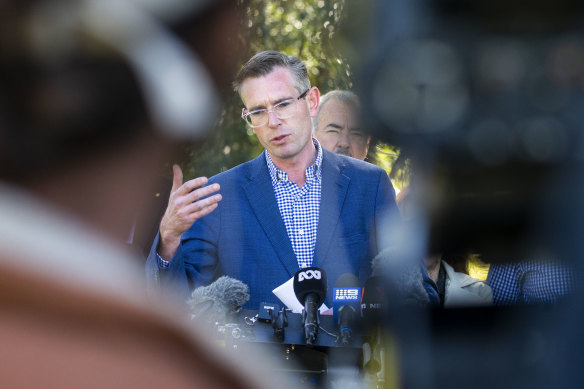NSW will overhaul its handling of natural disasters following a scathing independent flood inquiry report, which urged a major reset of emergency management in the face of increasing extreme weather events.
The Perrottet government will set up a permanent emergency operations centre, led by a new deputy police commissioner, while a new Cabinet committee of senior ministers – branded Task Force Hawk – will respond to any future major disaster.
NSW Premier Dominic Perrottet announcing the government’s response to the inquiry on Wednesday.Credit:AFR
In flood-hit Lismore on Wednesday, NSW Premier Dominic Perrottet said the report by former police commissioner Mick Fuller and Professor Mary O’Kane made for “hard reading,” with critical assessments of the NSW State Emergency Service and Resilience NSW, as well as urging the creation of a land swap and buyback scheme for Northern Rivers residents and others on NSW floodplains.
However, no details on the land swap or buyback schemes were made available on Wednesday, only that expressions of interest would open at the end of August with a response before Christmas.
Back office operations of the Rural Fire Service and the State Emergency Service will be merged, and training will be made available to residents in flood-prone areas on conducting rescues using their own boats. A permanent reconstruction and disaster prevention authority also will be established.
The premier acknowledged the work of the emergency agencies and their tireless volunteers and public servants during the flood crisis, but said lessons from the emergency could not be ignored in the face of future risks.
Karri Crossing and Hayden Muirhead with one-week-old baby Ziggy and daughter Juno; Lismore after the flood peaked on February 28; A Lismore street, days later; A warning sign on a fence of a home along the river in Woodburn.
“We cannot keep doing things the same way that we’ve done in the past. We need to do things differently,” Perrottet said, vowing to accept all 28 recommendations of the report.
Black Summer fire hero Shane Fitzsimmons, boss of Resilience NSW, has fallen victim to the government’s change in thinking, with his agency to be swallowed by Recovery NSW, a smaller “leaner body” focused on the first 100 days after a disaster.
The report included criticism levelled at the disaster agency by local councils and communities, which described a failure to prepare, inadequate engagement and unacceptable delays at evacuation centres.
Fitzsimmons hit back at the report, ahead of its release, describing its findings as disappointing, without evidence and based on inaccurate information.
In an internal email on Wednesday, seen by the Herald, he urged agency staff not to lose sight of the “extraordinary tragedy” of the Northern Rivers floods and disputed “inaccurate or incorrect information and assumptions” in the report.
Perrottet later said he supported the recommendation to scale down Resilience NSW, adding that he had spoken to Fitzsimmons about the role he would play through the transition.
Fitzsimmons was contacted for comment.
The premier commissioned the inquiry by the two former public servants to investigate the causes of the deadly floods in the Northern Rivers and the Hawkesbury Nepean region between February and March this year. More than 5000 homes were left uninhabitable, nine lives were lost and at least 2000 kilometres of road were damaged. More than 1000 people are still living out of their home or homeless today as a result.
Fuller and O’Kane received almost 1500 submissions to the inquiry and conducted 144 community meetings.
Their final report found the NSW SES failed to use available resources and did not follow current rescue guidelines. It determined the volunteer agency did not have the operational ability to coordinate multiple flood rescues, hearing evidence up to 3000 phone calls for help were lost in Lismore alone during the crisis.
The report also called for new methods to understand future climate risks and the impact on extreme rainfall and flooding, insisting the need for NSW to become a leader in responding to rapidly changing climate change science.
The premier acknowledged the flooding occurred across the state in the first half of 2022, but said, “nowhere has it been worse, or as devastating, traumatic and distressing for our communities as in the Northern Rivers”.
Perrottet said the new reconstruction body will be based on the Queensland Reconstruction Authority, with legislative powers. He said the government was committed to land swaps and buybacks in targeted areas.
“I know for many people that provides uncertainty today, in terms of eligibility, but that is something that we need to work through,” he said.
Labor member for Lismore Janelle Saffin said locals had hoped for more detail on planning and reconstruction in Wednesday’s report, with many still hamstrung over the future of their flood-ravaged properties.
“Some people want to stay, other people are really nervous to stay. The locals would have liked detail, with the buyback and the relocatables, today,” she said.
“It will cost a lot of money. But we live in the country and see how money is spent in the city on roads, ferries, trains, tolls, the wastage. It’s our turn.“
Lismore mayor Steve Krieg said his biggest concern was the number of people still unable to return to a home, with 1400 people still in emergency accommodation in the past week.
“Right from the outset we knew keeping people safe and secure in some form of housing was a necessity and that still hasn’t been addressed adequately,” he said.
The Morning Edition newsletter is our guide to the day’s most important and interesting stories, analysis and insights. Sign up here.
Most Viewed in Politics
From our partners
Source: Read Full Article
